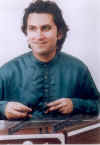
He was invited, as a finale to the 3 day Taramati Festival at Taramati Baradari to perform a unique presentation "Peace & Joy" He was joined by his son, Rahul Sharma on the Santoor, Taufiq Qureshi on Western Drums, Ustaad Shafaat Ahmed on the Tabla and Selva Ganesh on Kanjeera (kind of damru)
They were just back from Meghalaya and on their way to Nairobi for another concert.
At the risk of sounding like my 16yr old sister, Rahul is "Soooooooooooo Cute................" (She reserves this compliment for Australian Cricketers, tho)
 He too, plays the Santoor. Although, while Panditji is focussing on concerts, Rahul is focussing on Music Albums. He is all set to release his next album "Jannat" - the first musical album to document the culture & traditions of strife torn Jammu & Kashmir. After this he plans to work on "Maya - the illusion." He has also recently scored music for Tanuja Chandra's English Film "Hope & a Little Sugar"
He too, plays the Santoor. Although, while Panditji is focussing on concerts, Rahul is focussing on Music Albums. He is all set to release his next album "Jannat" - the first musical album to document the culture & traditions of strife torn Jammu & Kashmir. After this he plans to work on "Maya - the illusion." He has also recently scored music for Tanuja Chandra's English Film "Hope & a Little Sugar"
The seating was open air in an amphitheatre style, with the historic Taramati Baradari as the backdrop on which a play of lights continued throughout the evening. This centuries old monument is where Taramati used to dance for the Golconda king. Legend has it that, the acoustics were such that he could hear her sing from here, when he was seated at the top of the fort. And on Fridays, after Namaaz, she would sing and dance her way to the Fort.
It was in this magical setting, that Pandit Shiv Kumar and his troupe kept the audience enthralled. He started playing around 10PM and by this time only the real music lovers were left, the page 3 varieties had departed after getting their photos clicked by the reporters. For an hour and a half, we were mesmerised & hypnotised by the music. Some parts were solos, some were percussion combinations, a jugalbandi and an amusing range of instruments simulated by Taufiq Qureshi. So much variety in continuity. Words cannot describe the music. It needs to be heard and experienced by each person individually. To listen to such music, in such surroundings, is as close to paradise as it gets on earth. For an hour and a half, I was in Jannat.









1 comment:
I have been listening to Western classical music since 1977 and Indian classical music since 1985.
Hariprasad Chaurasia, Shiv Kumar Sharma, Kishori Amonkar, Kumar Gandharva, Bismilla Khan, Allah Rakha and Zakir Hussain and a host of other virtuosos have given me immense pleasure over the years (decades, now that I have reached old age). The santoor is an exceptionally melodious instrument, with a tonal quality that would satisfy even the crustiest Western impresario!
Indian classical music focuses almost entirely on melody. The tonal quality of the instrument or the timbre of the voice is of secondary importance.
Western classical music focuses entirely on musical structure, precision and cohesion. Tonal quality and richness of voice is of paramount importance. Hence you have in Indian classical music, instruments like the sarod and the sitar, whose tonal qualities are controversial. However, the santoor is an instrument
that brings out the best in melody without compromising on the highest possible tonal quality. No wonder you enjoyed the concert!
Gerard Colaco
Post a Comment